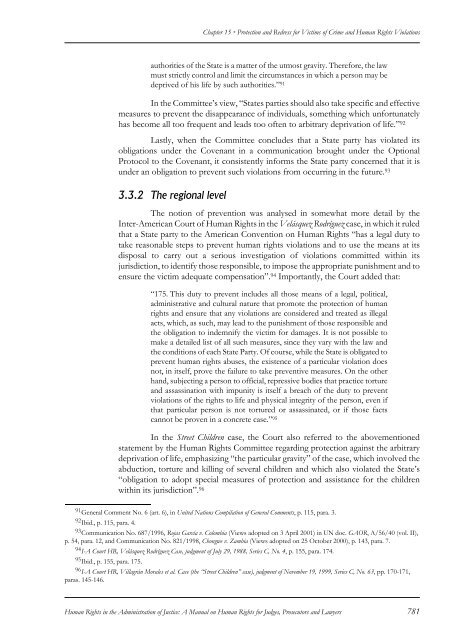protection and redress for victims of crime and human rights violations
protection and redress for victims of crime and human rights violations
protection and redress for victims of crime and human rights violations
You also want an ePaper? Increase the reach of your titles
YUMPU automatically turns print PDFs into web optimized ePapers that Google loves.
Chapter 15 • Protection <strong>and</strong> Redress <strong>for</strong> Victims <strong>of</strong> Crime <strong>and</strong> Human Rights Violationsauthorities <strong>of</strong> the State is a matter <strong>of</strong> the utmost gravity. There<strong>for</strong>e, the lawmust strictly control <strong>and</strong> limit the circumstances in which a person may bedeprived <strong>of</strong> his life by such authorities.” 91In the Committee’s view, “States parties should also take specific <strong>and</strong> effectivemeasures to prevent the disappearance <strong>of</strong> individuals, something which un<strong>for</strong>tunatelyhas become all too frequent <strong>and</strong> leads too <strong>of</strong>ten to arbitrary deprivation <strong>of</strong> life.” 92Lastly, when the Committee concludes that a State party has violated itsobligations under the Covenant in a communication brought under the OptionalProtocol to the Covenant, it consistently in<strong>for</strong>ms the State party concerned that it isunder an obligation to prevent such <strong>violations</strong> from occurring in the future. 933.3.2 The regional levelThe notion <strong>of</strong> prevention was analysed in somewhat more detail by theInter-American Court <strong>of</strong> Human Rights in the Velásquez Rodríguez case, in which it ruledthat a State party to the American Convention on Human Rights “has a legal duty totake reasonable steps to prevent <strong>human</strong> <strong>rights</strong> <strong>violations</strong> <strong>and</strong> to use the means at itsdisposal to carry out a serious investigation <strong>of</strong> <strong>violations</strong> committed within itsjurisdiction, to identify those responsible, to impose the appropriate punishment <strong>and</strong> toensure the victim adequate compensation”. 94 Importantly, the Court added that:“175. This duty to prevent includes all those means <strong>of</strong> a legal, political,administrative <strong>and</strong> cultural nature that promote the <strong>protection</strong> <strong>of</strong> <strong>human</strong><strong>rights</strong> <strong>and</strong> ensure that any <strong>violations</strong> are considered <strong>and</strong> treated as illegalacts, which, as such, may lead to the punishment <strong>of</strong> those responsible <strong>and</strong>the obligation to indemnify the victim <strong>for</strong> damages. It is not possible tomake a detailed list <strong>of</strong> all such measures, since they vary with the law <strong>and</strong>the conditions <strong>of</strong> each State Party. Of course, while the State is obligated toprevent <strong>human</strong> <strong>rights</strong> abuses, the existence <strong>of</strong> a particular violation doesnot, in itself, prove the failure to take preventive measures. On the otherh<strong>and</strong>, subjecting a person to <strong>of</strong>ficial, repressive bodies that practice torture<strong>and</strong> assassination with impunity is itself a breach <strong>of</strong> the duty to prevent<strong>violations</strong> <strong>of</strong> the <strong>rights</strong> to life <strong>and</strong> physical integrity <strong>of</strong> the person, even ifthat particular person is not tortured or assassinated, or if those factscannot be proven in a concrete case.” 95In the Street Children case, the Court also referred to the abovementionedstatement by the Human Rights Committee regarding <strong>protection</strong> against the arbitrarydeprivation <strong>of</strong> life, emphasizing “the particular gravity” <strong>of</strong> the case, which involved theabduction, torture <strong>and</strong> killing <strong>of</strong> several children <strong>and</strong> which also violated the State’s“obligation to adopt special measures <strong>of</strong> <strong>protection</strong> <strong>and</strong> assistance <strong>for</strong> the childrenwithin its jurisdiction”. 9691 General Comment No. 6 (art. 6), in United Nations Compilation <strong>of</strong> General Comments, p. 115, para. 3.92 Ibid., p. 115, para. 4.93 Communication No. 687/1996, Rojas García v. Colombia (Views adopted on 3 April 2001) in UN doc. GAOR, A/56/40 (vol. II),p. 54, para. 12, <strong>and</strong> Communication No. 821/1998, Chongwe v. Zambia (Views adopted on 25 October 2000), p. 143, para. 7.94 I-A Court HR, Velásquez Rodríguez Case, judgment <strong>of</strong> July 29, 1988, Series C, No. 4, p. 155, para. 174.95 Ibid., p. 155, para. 175.96 I-A Court HR, Villagrán Morales et al. Case (the “Street Children” case), judgment <strong>of</strong> November 19, 1999, Series C, No. 63, pp. 170-171,paras. 145-146.Human Rights in the Administration <strong>of</strong> Justice: A Manual on Human Rights <strong>for</strong> Judges, Prosecutors <strong>and</strong> Lawyers 781
















